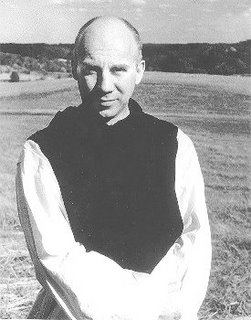Friar Louis: The Silent Yes

Thomas Merton, a Trappist monk, poet and religious writer, known as "Friar Louis," was born on this day in 1915 in Prades, France to a New Zealand painter and his American wife.
Despite having taken vows of silence as a Trappist monk at the age of 26, through his writings Thomas Merton became a leader in the revival of Catholic monasticism after World War II, a voice for social justice during the 1950s and 60s and an important Western interpreter of Asian mysticism.
His mother died when he was 6, and his father kept him in school in Bermuda, New York, France and England until his death in 1931. The promising youth received a scholarship to Cambridge in 1933, but after a chaotic year in which it is believed he fathered a child out of wedlock, his guardian removed him from Cambridge and sent him to Columbia University, where he met his future lifelong correspondents, painter Ad Reinhardt and poet Robert Lax, and received his bachelor's degree in English in 1938. Under Mark Van Doren he wrote a master's thesis on William Blake and, influenced by his studies of medieval philosophy, he converted to Catholicism.
After a teaching stint and an attempt to enter the Franciscans, Merton became a Trappist monk, entering the monastery of the Cistercians of Strict Observance, Our Lady of Gethsemani, near Bardstown, Kentucky in 1941. Although his vow of silence initially imposed severe restrictions on his writing, eventually his superiors at the monastery gave him writing assignments, permitting him to publish poems and literary criticism during the 1940s, culminating in the administration's suggestion that he write the story of his own conversion. His spiritual autobiography, The Seven Storey Mountain
Still, Merton was a reluctant celebrity, choosing to focus on monastery activities, attaining the position of master of novices in 1955. He again came into conflict with his vow of silence as his writing began to advocate social justice, pacifism, racial harmony and the need for political activism through the church -- views eventually shared, however, in the attitudes of Pope John XXIII and the Second Vatican Council, with its emphasis on human problems and the needs of secular society. Thus by the late 1950s Merton was virtually free to publish anything he wished -- though at least some of his writings continued to wrestle with the paradox of being the monk isolated from the world yet making a political choice not to ignore its ills.
At that time, his interest in Eastern religion, particularly Zen Buddhism, blossomed. In Zen, he found new modes of expression for his ascetic outlook, which he explored in such works as A Search for Solitude (1952-60), Mystics and Zen Masters (1961) and Zen and the Birds of Appetite (1968, including a dialogue with D.T. Suzuki). In the 1960s, he was granted permission to leave the monastery to live as a hermit on the grounds, but his fame interfered with his desire for seclusion as he greeted curious visitors and admirers from Joan Baez to Jacques Maritain and Daniel Berrigan.
In 1968, he prevailed upon his superiors to permit him to travel to Asia, where he met with the Dalai Lama and addressed Buddhist monks in Thailand. Sadly, while visiting Thailand Merton was accidentally electrocuted to death by a defective fan on December 10, 1968 -- 27 years to the day from his entrance to the monastery. Since his death, Merton's socially and politically-tinged writings, including Disputed Questions (1960), Seeds of Destruction (1964) and Faith and Violence (1968) have risen in reputation and influence, along with numerous posthumously published journals.
For more information, see also The Thomas Merton Center.
Categories: Christian-History, Peace-Activism, Buddhism





0 Comments:
Post a Comment
Subscribe to Post Comments [Atom]
<< Home